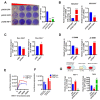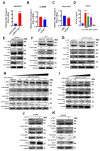Broadly Antiviral Activities of TAP1 through Activating the TBK1-IRF3-Mediated Type I Interferon Production
- PMID: 33925089
- PMCID: PMC8125511
- DOI: 10.3390/ijms22094668
Broadly Antiviral Activities of TAP1 through Activating the TBK1-IRF3-Mediated Type I Interferon Production
Abstract
Deeply understanding the virus-host interaction is a prerequisite for developing effective anti-viral strategies. Traditionally, the transporter associated with antigen processing type 1 (TAP1) is critical for antigen presentation to regulate adaptive immunity. However, its role in controlling viral infections through modulating innate immune signaling is not yet fully understood. In the present study, we reported that TAP1, as a product of interferon-stimulated genes (ISGs), had broadly antiviral activity against various viruses such as herpes simplex virus 1 (HSV-1), adenoviruses (AdV), vesicular stomatitis virus (VSV), dengue virus (DENV), Zika virus (ZIKV), and influenza virus (PR8) etc. This antiviral activity by TAP1 was further confirmed by series of loss-of-function and gain-of-function experiments. Our further investigation revealed that TAP1 significantly promoted the interferon (IFN)-β production through activating the TANK binding kinase-1 (TBK1) and the interferon regulatory factor 3 (IRF3) signaling transduction. Our work highlighted the broadly anti-viral function of TAP1 by modulating innate immunity, which is independent of its well-known function of antigen presentation. This study will provide insights into developing novel vaccination and immunotherapy strategies against emerging infectious diseases.
Keywords: broadly antiviral activity; innate immunity; interferon-stimulated genes (ISGs); transporter associated with antigen processing 1 (TAP1); type I interferons (IFN-Is).
Conflict of interest statement
The authors declare no conflict of interest.
Figures






Similar articles
-
Two Conserved Amino Acids within the NSs of Severe Fever with Thrombocytopenia Syndrome Phlebovirus Are Essential for Anti-interferon Activity.J Virol. 2018 Sep 12;92(19):e00706-18. doi: 10.1128/JVI.00706-18. Print 2018 Oct 1. J Virol. 2018. PMID: 30021900 Free PMC article.
-
Heartland virus NSs protein disrupts host defenses by blocking the TBK1 kinase-IRF3 transcription factor interaction and signaling required for interferon induction.J Biol Chem. 2017 Oct 6;292(40):16722-16733. doi: 10.1074/jbc.M117.805127. Epub 2017 Aug 28. J Biol Chem. 2017. PMID: 28848048 Free PMC article.
-
eIF4A3 Promotes RNA Viruses' Replication by Inhibiting Innate Immune Responses.J Virol. 2022 Nov 23;96(22):e0151322. doi: 10.1128/jvi.01513-22. Epub 2022 Oct 31. J Virol. 2022. PMID: 36314820 Free PMC article.
-
TANK-binding kinase 1 as a novel therapeutic target for viral diseases.Expert Opin Ther Targets. 2019 May;23(5):437-446. doi: 10.1080/14728222.2019.1601702. Epub 2019 Apr 10. Expert Opin Ther Targets. 2019. PMID: 30932713 Review.
-
Interferon-Stimulated Genes as Enhancers of Antiviral Innate Immune Signaling.J Innate Immun. 2018;10(2):85-93. doi: 10.1159/000484258. Epub 2017 Nov 30. J Innate Immun. 2018. PMID: 29186718 Free PMC article. Review.
Cited by
-
TRIM21 reduces H1N1-induced inflammation and apoptosis by regulating the TBK1-IRF3 signaling pathway in A549 cells.Arch Virol. 2024 Mar 13;169(4):74. doi: 10.1007/s00705-024-05989-6. Arch Virol. 2024. PMID: 38480558
-
Epigenetic control over the cell-intrinsic immune response antagonizes self-renewal in acute myeloid leukemia.Blood. 2024 May 30;143(22):2284-2299. doi: 10.1182/blood.2023021640. Blood. 2024. PMID: 38457355 Free PMC article.
-
Temporally integrated transcriptome analysis reveals ASFV pathology and host response dynamics.Front Immunol. 2022 Dec 5;13:995998. doi: 10.3389/fimmu.2022.995998. eCollection 2022. Front Immunol. 2022. PMID: 36544767 Free PMC article.
-
Integrated analysis of immune parameters, miRNA-mRNA interaction, and immune genes expression in the liver of rainbow trout following infectious hematopoietic necrosis virus infection.Front Immunol. 2022 Sep 2;13:970321. doi: 10.3389/fimmu.2022.970321. eCollection 2022. Front Immunol. 2022. PMID: 36119061 Free PMC article.
-
A complex remodeling of cellular homeostasis distinguishes RSV/SARS-CoV-2 co-infected A549-hACE2 expressing cell lines.Microb Cell. 2024 Oct 8;11:353-367. doi: 10.15698/mic2024.10.838. eCollection 2024. Microb Cell. 2024. PMID: 39421150 Free PMC article.
References
MeSH terms
Substances
Grants and funding
LinkOut - more resources
Full Text Sources
Other Literature Sources
Research Materials
Miscellaneous

